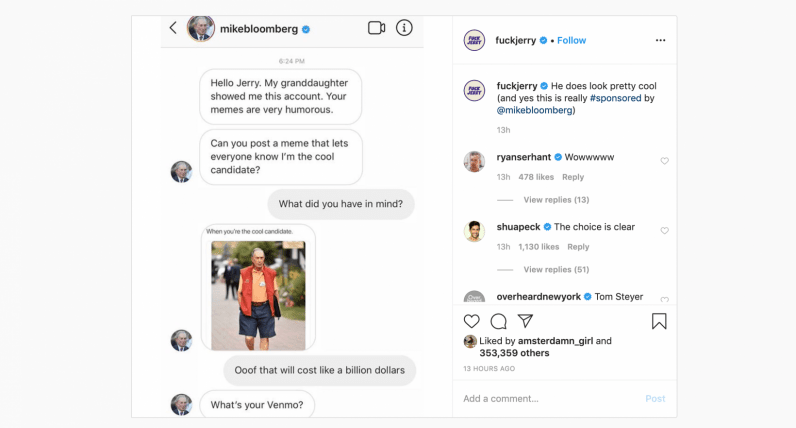I’ll be honest, since Donald Trump’s 2016 presidential victory I’ve been entirely disassociated from American politics. Us Brits have had our own veritable smorgasbord of political controversy to keep us occupied throughout the last four years, and whenever I did dip my toe back in to the ‘swamp’ – such as with the death of Qasem Soleimani – the flip-flapping of both the president’s mouth and his Tango orange fringe trivialised what should have been a captivating geo-political occurrence. He managed to chlorinate the proverbial waters, making it impossible to distinguish between truth and ‘fake news’.
Imagine my surprise then, when the thing to reignite my interest in the political happenings across the pond is the presidential campaign of yet another notable, divisive and mouth-flapping multi-billionaire, although this time more a white spirit than Tango. Indeed, Michael R. Bloomberg’s now short lived attempt at becoming the Democrat’s Trump had certainly made the presidential race interesting again – if only for the plethora of experimental and morally devoid campaign tactics on show.
If you’re out of the loop, Bloomberg ‘suspended’ his $500 million presidential run last week. But over the few months had been – unsurprisingly – throwing a rather large amount of cash at his campaign team to cultivate an online presence (or create the appearance of one), hopefully getting his name on the nomination list by hiring hundreds of ‘temporary employees’ to promote designated campaign messaging throughout key social platforms (Instagram, Twitter and Facebook). These ‘deputy field organizers’, in some instances, received close to $3000 a month to post about the former New York mayor. Paid to simply post pre-made and orchestrated campaign content on their personal channels when asked.

What separates this from the usual influencer marketing strategy? I hear you cry. Well these accounts weren’t hired for their already existing following. A lot of the accounts used on Twitter had no following at all and were created from scratch. Bloomberg’s campaign team had effectively created a bot network of social media accounts who were all sharing repeated and untargeted propaganda. Twitter was fairly quick to determine this approach as having broken its Platform Manipulation and Spam Policy, suspending over 70 Pro-Bloomberg accounts but, to me, this was big news. The use of bots to manipulate the public had been widely reported before, but the belief that the west were also making use of them was still seen as a conspiracy by many. The façade had briefly slipped, and the electorate were privy to a level of manipulation they rarely see. I mean, let’s be honest. The concept of social media bot networks wouldn’t feel out of place in an dystopian novel, and suggestions of their utilisation during the 2016 referendum were quickly ridiculed. Yet, concrete proof had arisen and cemented the notion that even prominent American based campaigns were utilising them. With bots becoming increasingly difficult to detect, this was a huge problem.
Since the 2016 UK/EU referendum and the Trump election the spotlight has been permanently set on the likes of Mark Zuckerberg to see what kind of riposte would materialise to the, in some cases, illegal manipulation of their platforms. Carole Cadwalladr had done a superb job in the UK of showing how 21st digital and social media laws were wilfully redundant and had led to campaigners utilising unchecked lies, illegally harvested data and microtargeting to effectively infringe on democracy. So, Like many others, I awaited, with baited breath, for some recognition and change from the platforms. Change did eventually come. Albeit not the wholesale changes that were drastically needed but they were still progressive signs and steps taken. Facebook and Instagram introduced a fact checking function and added features to its Ad Library, which lets anyone see any live political ad, and they gave users more control over what type of ads appear on their feed. Twitter took a more drastic approach and outright banned paid political adverts altogether, as well as updating their policy on organic manipulation.
Political campaigners were now limited in ways they weren’t before, meaning any future campaign would need to find a way to permeate social media somewhat organically. And that Is why Bloomberg’s campaign was flagged, and why I was subsequently interested in American politics once more. How was his morally bereft campaign team going to best utilise a half a billion dollar chequebook? and will the new limitations of social media restrict them?
The answer? Nope.
Several weeks in to Bloomberg’s run, his campaign director, Evan Reeves, exposed a loophole in Instagram’s policy to harness paid ads, masquerading with, admittedly, humorous and self-aware direct messages to reach millions. Paying high following accounts on Instagram to post imagery conversations with Bloomberg himself. In fact, several hours after the pro-Bloomberg posts went live, Instagram caved and amended its policy. Unequivocally approving paid content as long as its visibly clear who’s paying for it.

Twitter had restricted Bloomberg’s attempts at using bots, but Facebook and Instagram were all too happy to enable and promote the bending of their rules as long as it equated in cash. And this kind of dishonesty will keep happening. In every election or referendum hereafter, unless legislative change is introduced. Even as recently as last week, thousands of Russian-made social media accounts were found to have spread misinformation about the cause and treatment of coronavirus, disrupting global efforts to fight the epidemic.
Campaigns such as Reform Political Advertising are doing a good job of highlighting the misuse of social media. Give them a follow, get involved and potentially help bring about a much needed change in the functioning of our democracy.
